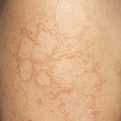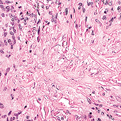Granuloma Annulare
General Information
Granuloma Annulare (GA) is a common condition that appears in places that are subject to frequent, mild injury such as the back of the hands or top of the feet. The condition is mostly seen in older children and young adults. Generalized and localized GA lesions usually manifest as asymptomatic cutaneous lesions. The lesions have a tendency to improve during the wintertime and worsen during the summer. Subcutaneous GA most often manifests as a large, asymptomatic soft tissue mass. The nodules are normally stable for months then they may rapidly enlarge over the course of weeks. Treatment is not necessary, as most lesions will disappear on their own within weeks to a couple of years. If a patient is bothered by the appearance a healthcare provider may recommend Corticosteroid creams or ointments; Corticosteroid injections; Freezing the lesions (cryotherapy) or Light therapy.
Epidemiology
Uncommon dermatosis
Etiology
Unknown
Pathogenesis
Manifest as asymptomatic cutaneous lesions
Clinical
Dermal papules and annular plaques
Histology
Early interstitial or incomplete lesions show an interstitial pattern characterized by lymphocytes around vessels of the superficial and deep plexuses and by macrophages scattered between reticular dermal collagen bundles that are separated by mucin within which mast cells may be found. Fully evolved lesions and deep subcutaneous GA nodules demonstrate palisaded granulomatous dermatitis or a septal and lobular panniculitis, respectively
Bibliography
1. “Granuloma Annulare” (Online). http://www.aocd.org/skin/dermatologic_diseases/granuloma_annulare.html (visited: March 18, 2008) 2. “Granuloma Annulare” (Online) March 2007. http://www.emedicine.com/derm/topic169.htm (visited: March 18, 2008)
Download PDF
![]() Granuloma Annulare
Granuloma Annulare


